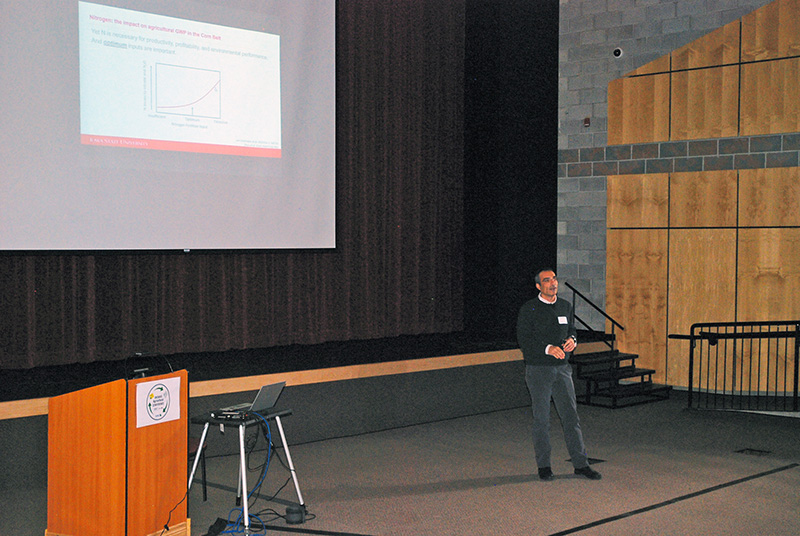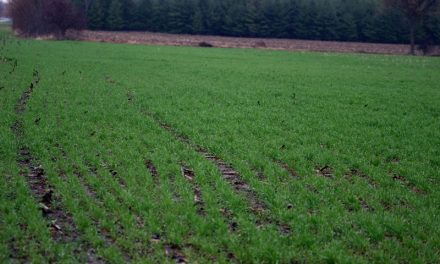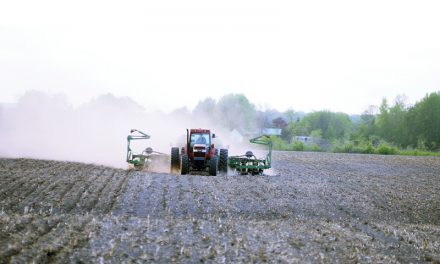Dr. Mike Castellano topic was Drainage Impacts. His was an in-person presentation. He is a Professor of Agronomy and William T. Frakenberger Professor of Soil Science at Iowa State University. He spoke about how to better manage the storage and flow of nutrients, energy, and water throughout the crop-soil system as they impact on productivity, profitability, and environmental performance. Morin Photo
The North Grenville Municipal Centre in Kemptville enjoyed a busy day early in 2023 with the arrival of the Ontario Agricultural Conference.
The event took place Wed., Jan. 4 in Kemptville, and was one of three different in-person locations where agriculture presentations and information sharing was front and centre for the provinces’ farmers.
The event featured simultaneous conferences in Ridegtown, Waterloo and Kemptville with Ridgetown having an extra day of presentations on Jan. 5. The three locations each represented a different conference group. They are the Southwest Agricultural Conference, Midwestern Ontario Agricultural Conference and the Eastern Ontario Crop Conference.
Visitors to the conference were treated to 50 different presenters, each showcasing their own topics related to agriculture. The Ontario Agriculture Conference organizers came up with a novel idea of hosting the three locations with in-person and virtual presentations. This created an opportunity for visitors to have access to more information than in the past. For those registered for the event, they will be able to find any presentations they missed online until March 2023.
Chair of the Eastern Ontario Crop advisory committee Scott Banks was pleased with the positive reaction visitors had to the in-person and online presentations.
“The Eastern Ontario Crop Advisory committee has been doing this for about 20 years now,” said Banks.
He said this year’s event was an idea they were trying out that mixed virtual and in- person presentations that were recorded for immediate viewing and for later use.
The conference featured 50 different topics with titles ranging from Sizzlin’ Soybeans to Winning with Nitrogen, and Positives of Climate Change, to name three interesting presentations. The information in all of the presentations was delivered by experts from across North America from that particular field.
Bouncing back from Covid and employing the new ideas in the event Banks said around 90 people had registered for the in-person event in Kemptville alone and thirteen vendors had joined in as well. At the time of the conference there was not several registered online visitors available.
“We are testing the water and we’ll see how it goes.”
Banks said if this version of the conference, goes well, they would like to continue it and build on it as well.
Along with the new version sharing presentations between online and in-person organizers have come up with a new idea called TEC TALK Tuesdays.
From 7:27 p.m. to 8:57 p.m. every Tuesday evening from Jan. 10 to Feb. 21 different topics will be up for discussion, and people taking part will be able to ask questions.
The amount of information available to visitors to the conference was almost overwhelming. One interesting topic featured in an online presentation was called Cover Crop Recopies presented by Anne Verhallen from OMAFRA.
She was presenting from the University of Guelph Ridgetown Campus.
Verhallen began by explaining: “Today we’re going to talk about recipes. I often get asked about what’s the best recipe for a cover up? What’s my favourite cover crop? Well, I often think about cover crops as being kind of like brownies, right? You have a visual image of what it should be and what it should taste like. But it can be a lot more than just the basic brownie. As we add some complication in the form of nuts and things like that, or we could get a lot fancier, it still comes down to it’s a brownie. It’s a dessert. It’s lovely.”
She said the Midwest Cover Crop Council put together a series of cover crop recipes. “So if you go to their website, you will find a series of recipes for each of the states and the provinces that are part of the council. And in particular, I’d like to point you to the ones from Ontario. We have worked hard on coming up with some that really reflect how we grow crops here.”
She said picking what cover crops you might use depends on your particular goals. “What are you trying to get out of a cover crop through the course of this session? She said, “We’re going to talk to or listen to about 12 different farmers mostly from Ontario, but one from Quebec and also one from Michigan.”
First up to explain his recipe was Woody Van Arkel who has a farm in Ontario.
“I grow corn soybeans, wheat, sugar beets, sunflowers, and trying sesame. I also have a hog finishing barn operations for a contract fee. So I have three goals for my farm and that is to keep a living root system growing in the soil 365 days a year. Keep the soil covered as much as possible, and to do as little tillage as possible all under the umbrella of economic feasibility as far as growing the crop is concerned.” he said.
Arkel said, “One of the things I’ve learned is it’s important to be able to manage those cover crops in the spring in a manner that it doesn’t interfere with the planting of the next year’s crop. This is where the combination of cover crops and strip tilled has been very effective. It offers me a viable seed bed in the spring while still getting 80 per cent of my ground covered by an overwintering cover crop. So one of the other benefits of using cover crops is that I try to utilize it as cycling nutrients, particularly from manure.”
He explained on the field he was standing he has used about a third commercial fertilizer, and two thirds of hog manure he applied last year using the cover crops to carry it over into this year’s crop.
“If I have the opportunity to incorporate red clover into a cover crop mix head of sugar beets, I will do that as much as possible. With the herbicide options I have available it’s easy enough to control the red clover and not have it become a concern in the sugar beet crops. Moving forward, I’d like to do more work with testing how much available nitrogen a good standard red clover brings towards a beet crop. It’s still a little bit of a guessing game for now.”
Verhallen said, “Our next farmer has similar goals but he also has cows and sheep.” Gordon Albais lives close to St. George Ontario Farm with his parents and about 60 cows.
“We like to grow cover crops when we can. The first reason I grow cover crops is to keep the field green over the winter. The second main reason I grow it is for livestock feed. In the past we have found results very positive when feeding it to our dairy cattle.”
He has planted Australia and winter peas.
“We’ll have to see how that results in the spring. This year we tried forge turnips as well and the cows did quite well on it being a dry year. It was what mainly grew.”
He has been able to reduce erosion and build up the biomass in the soil.
There was a registration fee to the conference, which included access to all of the online content until March 2023.













